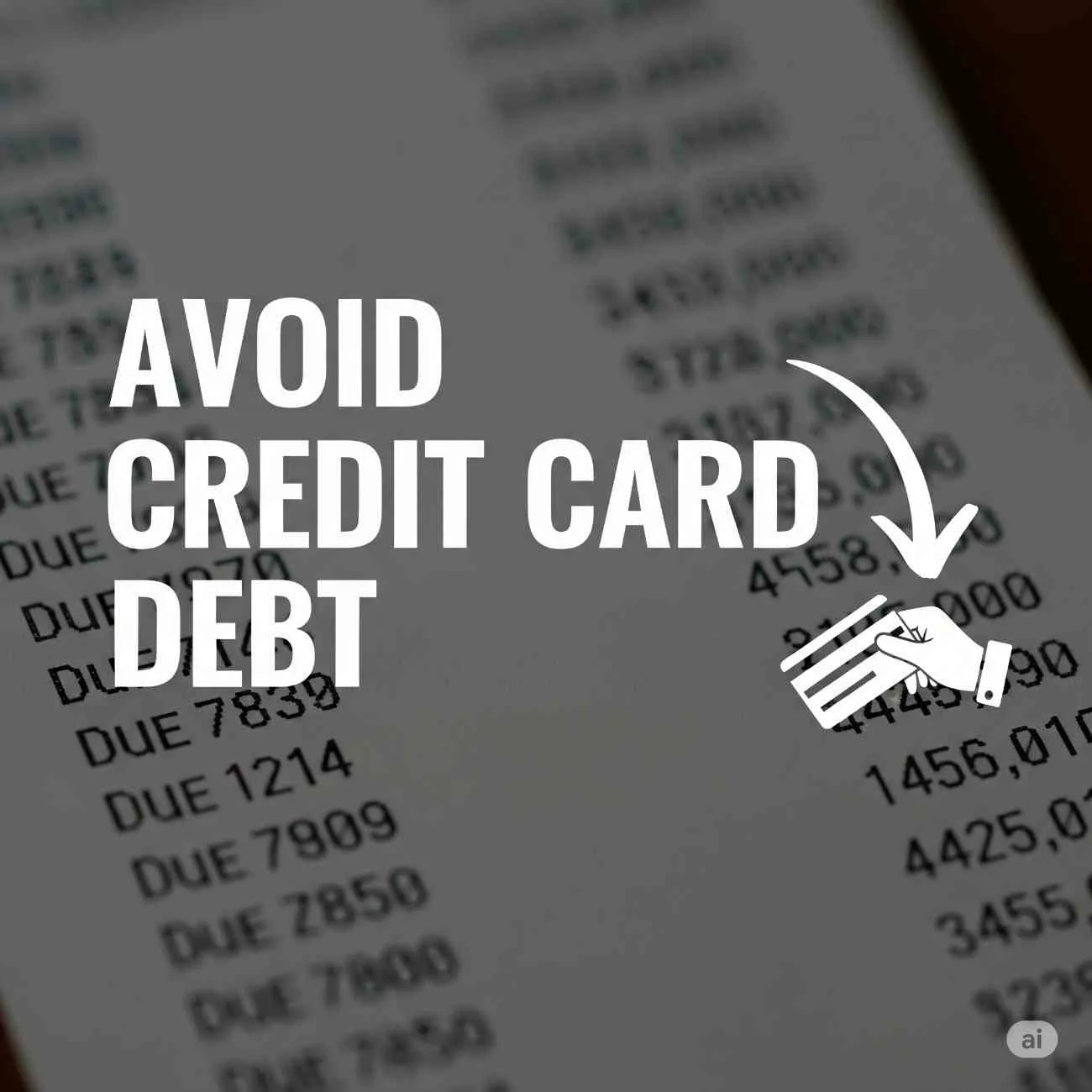
How to Avoid Credit Card Debt – Practical Tips for Tier 3 City Users
Credit cards are an essential financial tool, but they can also be a trap — especially in India’s Tier 3 cities where access to financial education is limited. If you're from a small town or semi-urban area and want to enjoy the benefits of credit cards without falling into a cycle of debt, this article is tailor-made for you. With rising interest rates, delayed salaries, and little support in vernacular languages, many users get stuck in a web of EMIs and penalties. But don't worry — we’re going to break it all down and help you stay debt-free in 2025.
Why Tier 3 City Users Are at Higher Risk of Credit Card Debt
Tier 3 users often face challenges like limited financial literacy, irregular income patterns, and aggressive sales pitches from DSA agents. Here’s why you need to be extra careful:
- 📉 Lack of awareness about APR (Annual Percentage Rate)
- 💸 Usage of credit cards for emergency needs like medical or school fees
- 🎉 Overuse during festivals without a payback plan
- 📲 No access to personal finance tools in local languages

Section 1: Understanding the Mechanics of Credit Card Debt
Credit card debt piles up not because people are careless, but because the product is misunderstood. Here’s how it works:
- 📅 Each card has a billing cycle and due date. Missing this results in interest + late fee.
- 📊 Paying only the “minimum due” leads to compounding interest of up to 42% per annum.
- 💵 Cash withdrawals start accruing interest from day one.
Know the Terms
Minimum Due: Usually 5% of your bill. Paying this avoids penalty but not interest.
Interest-Free Period: Usually 18–50 days. But only valid if no balance is carried forward.
EMI Conversion: Banks offer EMIs at 13–22% interest. Always calculate total cost.
Section 2: The 10 Golden Rules to Stay Debt-Free
- Always Pay the Full Due Amount – Don’t fall for minimum due trap.
- Track All Spends – Use tools like CRED, ET Money, or Google Sheets.
- Set Payment Reminders – Use auto-debit, apps, or UPI reminders.
- Don't Use Credit Cards for Rent or Tuition – Unless you can repay in full.
- Limit to 1 or 2 Cards – More cards = more tracking, more risk.
- Use Lifetime Free Cards with Alerts – Like the AU LIT Credit Card.
- Avoid Cash Withdrawals – ₹5000 cash can cost ₹7000 in a month.
- Convert to EMI Wisely – Only if it’s 0% or <14% and truly needed.
- Never Miss Due Dates – It drops your CIBIL and invites collections.
- Build a Monthly Budget – Plan monthly spends like mobile recharge, fuel, groceries.
Section 3: Best Credit Card for Tier 3 Users – AU LIT
Tier 3 city users need simplicity and control. That’s why the AU LIT Credit Card is a solid choice:
- ✅ Lifetime Free
- ✅ Custom packs – choose only lounge/fuel/rewards/OTT
- ✅ Track spend via app
- ✅ 1% Fuel Surcharge Waiver
- ✅ Instant Approval – no branch visit
Section 4: How to Use Credit Cards for Good (Not Debt)
- 🎯 Use cards only when you get rewards or cashback
- 🚨 Don’t use credit cards for impulse purchases
- 📈 Build credit score by paying in full for 6–12 months
- 💼 Use credit card bill as proof of address for visa/job/rentals
- 🎁 Grab offers like discounts on Swiggy, Amazon, travel – only if you needed it anyway
Section 5: Budgeting Tools for Non-Metro Users
- Google Sheets – Monthly template to track expense vs income
- ET Money – Syncs bank, credit card and investments
- Walnut – SMS-based expense tracker for low-data phones
- Money View – Simple UI with loan tracker and budget planner
Section 6: What to Do If You’re Already in Debt
- Stop using the card immediately
- Convert large dues to EMI (check interest rate)
- Request for balance transfer to 0% interest cards
- Take small personal loan from trusted NBFCs (not payday apps)
- Talk to the bank — many offer restructuring plans post-COVID
Section 7: Financial Literacy Sources in Regional Languages
If English is a barrier, follow these:
- YouTube: CA Rachana, Labour Law Advisor, Groww (Hindi)
- Apps: Fello, Fi Money (English + Hindi)
- Community Pages: CreditPlanner Instagram, WhatsApp groups
FAQs – Avoiding Credit Card Debt in Tier 3 Cities
Which credit card is best for beginners in small towns?
AU LIT or IDFC WOW Card are top choices – zero annual fee, simple approval, smart tracking features.
Can I pay rent with credit card?
Yes, using platforms like CRED RentPay, but you must repay full amount or convert to low-interest EMI.
Does missing one payment affect CIBIL?
Yes, even one missed payment gets reported and stays for 24 months. It drops your score and lowers loan approval chances.
Should I take loan to pay credit card dues?
Only if the personal loan interest is lower (10%–18%) and EMI tenure is flexible. Avoid payday apps.
Section 8: Real-Life Examples – Case Studies from Tier 3 Users
Case Study 1: Ravi from Gorakhpur
Ravi, a retail garment shop owner, started using his credit card to stock seasonal inventory. In 2022, he missed 3 consecutive payments and saw his CIBIL score drop from 745 to 610. He consolidated dues via a personal loan and now uses a card only for travel discounts and fuel surcharge waiver. He tracks all bills using a WhatsApp reminder bot and learned to save ₹1,200/month by using the AU LIT fuel pack.
Case Study 2: Neha from Durgapur
Neha, a school teacher, used her card for EMI payments during a medical emergency. The EMI rate was 24% annually. After reading CreditPlanner, she switched to a balance transfer card with 0% for 3 months, cleared dues via a family loan, and now uses only lifetime free cards. Her go-to is HDFC MoneyBack+ with auto-payment setup.
Section 9: Key Terms You Must Know (Glossary)
- APR (Annual Percentage Rate): Effective yearly interest you pay on unpaid card balances.
- Statement Date: The date your monthly bill is generated. Purchases after this date fall in next billing cycle.
- Due Date: The last day to pay your bill without penalty or interest.
- Revolving Credit: The credit you can keep reusing as you repay.
- Utilization Ratio: Ratio of used credit vs available limit. Try to keep it below 30%.
Section 10: Government & Bank Programs That Help
- RBI Moratorium: Though now ended, it helped restructure debts post-COVID. Some banks still allow restructuring upon request.
- Sachet Portal: Helps you raise complaints about card billing, fraud or harassment.
- SEBI-Investor Education: Offers basic financial education videos in 11 Indian languages.
- Bank Debt Counsellors: Visit your bank branch and ask for a loan/credit card advisor to plan EMI or settlement options.
Section 11: Psychological Hacks to Avoid Impulse Usage
- ❌ Delete credit card saved info from Amazon, Swiggy etc.
- 🛒 Make wishlist and wait 48 hrs before purchasing online
- 💳 Set low credit limits via net banking
- 👀 Put a post-it note on your card: “Do I really need this?”
- 🔕 Turn off promotional push notifications on apps
Section 12: Smart Use of Offers – Turn Discounts Into Savings
Offers on food delivery, mobile recharge or fuel should only be used if they’re saving money you would’ve spent anyway. Avoid buying items only to get the discount. Use sites like GrabOn, CashKaro or Desidime for community-rated coupon codes. Set a limit – for example, ₹500/month for UPI + card cashback game, not more.
Need help choosing your first or next credit card? Use our Free Card Matcher Tool.
Liked this post? Share with friends in Tier 3 cities or browse more finance tips at CreditPlanner.in.

